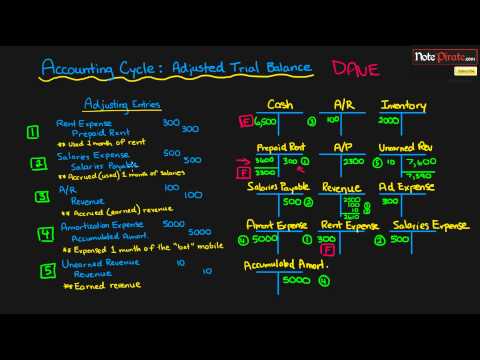4.6: Preparing an Adjusted Trial Balance
- Page ID
- 26196
| Accounting Cycle | ||
| 1. Analyze Transactions | 5. Prepare Adjusting Journal Entries | 9. Prepare Closing Entries |
| 2. Prepare Journal Entries | 6. Post Adjusting Journal Entries | 10. Post Closing Entries |
| 3. Post journal Entries | 7. Prepare Adjusted Trial Balance | 11. Prepare Post-Closing Trial Balance |
| 4. Prepare Unadjusted Trial Balance | 8. Prepare Financial Statements | |
In our detailed accounting cycle, we just finished step 5 preparing adjusting journal entries. The next step is to post the adjusting journal entries. We will use the same method of posting (ledger card or T-accounts) we used for step 3 as we are just updating the balances. Remember, you do not change your journal entries for posting — if you debit in an entry you debit when you post. After we post the adjusting entries, it is necessary to check our work and prepare an adjusted trial balance.
Let’s look at the company we have been using in our examples MicroTrain. The unadjusted trial balance is as follows:
| Debit | Credit | |
| Cash | 10,000 | |
| Accounts Receivable | 20,000 | |
| Supplies | 8,500 | |
| Prepaid Insurance | 2,400 | |
| Trucks | 40,000 | |
| Accounts Payable | 25,000 | |
| Unearned Revenue | 4,500 | |
| Common Stock | 35,000 | |
| Retained Earnings | 6,100 | |
| Service Revenue | 30,000 | |
| Salaries Expense | 18,000 | |
| Rent Expense | 1,200 | |
| Utilities Expense | 500 | |
| TOTALS | 100,600 | 100,600 |
The adjusting entries from the previous examples are:
| Debit | Credit | ||
| 1) Dec 31 | Accounts Receivable | 5,000 | |
| Service Revenue | 5,000 | ||
| To record December accrued revenue. | |||
| 2) Dec 31 | Interest Receivable | 600 | |
| Interest Revenue | 600 | ||
| To record December accrued interest revenue. | |||
| 3) Dec 31 | Salaries Expense | 360 | |
| Salaries Payable | 360 | ||
| To record salaries earned but not paid. | |||
| 4) Dec 31 | Unearned Revenue | 1,500 | |
| Service Revenue | 1,500 | ||
| To record deferred revenue now earned. | |||
| 5) Dec 31 | Insurance Expense | 200 | |
| Prepaid Insurance | 200 | ||
| To record one month of insurance expired. | |||
| 6) Dec 31 | Supplies expense | 7,000 | |
| Supplies | 7,000 | ||
| To record supplies used. | |||
| 7) Dec 31 | Depreciation Expense | 750 | |
| Accumulated Depreciation – Trucks | 750 | ||
| To record one month of depreciation. | |||
We can post these transactions using T-accounts or ledger cards. We are using the same posting accounts as we did for the unadjusted trial balance just adding on. Click Adj T-accounts to see the full posting. Notice how we start with the unadjusted trial balance in each account and add any debits on the left and any credits on the right.
Once the posting is complete and the new balances have been calculated, we prepare the adjusted trial balance. As before, the adjusted trial balance is a listing of all accounts with the ending balances and in this case it would be adjusted balances.
| Debit | Credit | |
| Cash | 10,000 | |
| Accounts Receivable | 25,000 | |
| Interest Receivable | 600 | |
| Supplies | 1,500 | |
| Prepaid Insurance | 2,200 | |
| Trucks | 40,000 | |
| Accum. Depreciation-Trucks | 750 | |
| Accounts Payable | 25,000 | |
| Unearned Revenue | 3,000 | |
| Salaries Payable | 360 | |
| Common Stock | 35,000 | |
| Retained Earnings | 6,100 | |
| Service Revenue | 36,500 | |
| Interest Revenue | 600 | |
| Salaries Expense | 18,360 | |
| Rent Expense | 1,200 | |
| Utilities Expense | 500 | |
| Insurance Expense | 200 | |
| Supplies Expense | 7,000 | |
| Depreciation Expense | 750 | |
| TOTALS | 107,310 | 107,310 |
The next step in the accounting cycle would be to complete the financial statements.
- Accounting Principles: A Business Perspective. Authored by: James Don Edwards, University of Georgia & Roger H. Hermanson, Georgia State University. Provided by: Endeavour International Corporation. Project: The Global Text Project . License: CC BY: Attribution
- Prepare an Adjusted Trial Balance. Authored by: Note Pirate. Located at: youtu.be/gwP0Pcm5C4I. License: All Rights Reserved. License Terms: Standard YouTube License


